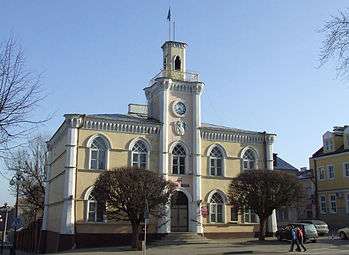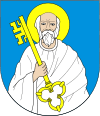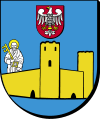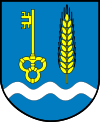Ciechanów
| Ciechanów | ||
|---|---|---|
|
Ciechanów Town Hall | ||
| ||
 Ciechanów | ||
| Coordinates: 52°52′N 20°38′E / 52.867°N 20.633°E | ||
| Country |
| |
| Voivodeship | Masovian | |
| County | Ciechanów County | |
| Gmina | Ciechanów (urban gmina) | |
| Established | 11th century | |
| Town rights | 1400 | |
| Government | ||
| • Mayor | Krzysztof Kosiński | |
| Area | ||
| • Total | 32.51 km2 (12.55 sq mi) | |
| Highest elevation | 151 m (495 ft) | |
| Lowest elevation | 116 m (381 ft) | |
| Population (2006) | ||
| • Total | 45,902 | |
| • Density | 1,400/km2 (3,700/sq mi) | |
| Time zone | CET (UTC+1) | |
| • Summer (DST) | CEST (UTC+2) | |
| Postal code | 06-400 to 06-413 | |
| Area code(s) | +48 023 | |
| Car plates | WCI | |
| Website | http://www.um.ciechanow.pl | |
Ciechanów [t͡ɕeˈxanuf] is a town in north-central Poland with 45,900 inhabitants (2006). It is situated in Masovian Voivodeship (since 1999). It was previously (1975–98) the capital of Ciechanów Voivodeship.
History
The settlement is first mentioned in a 1065 document by Bolesław II the Bold handing the land over to the church. The medieval gord in Ciechanów numbered approximately 3,000 armed men,[1] and together with the province of Mazovia, it probably became part of the Polish state in the late 10th century.
In 1254, Ciechanów is mentioned as the seat of a castellany (Rethiborius Castellanus de Techanow (Racibor, Kasztelan Ciechanowa)). In 1400 Janusz I of Czersk granted Ciechanów town privileges.[2] The area eventually become a separate duchy with Casimir I of Warsaw using the title "dominus et heres lub dominus et princeps Ciechanoviensis."
In the Middle Ages, the defensive gord of Ciechanów protected northern Mazovia from raids of Lithuanians, Yotvingians, Old Prussians and later, the Teutonic Knights. It is not known when it was granted a town charter. This must have happened before 1475, as a document from that year, issued by Duke Janusz II of Warsaw, states that Ciechanów has a Chełmno town charter.
In the period between the 14th and 16th centuries, Ciechanów prospered with the population reaching 5,000. In the late 14th century, Siemowit III, Duke of Masovia, began construction of a castle, while his son Janusz I of Warsaw invited the Augustinians, who in the mid-15th century began construction of a church and an abbey. In 1526, together with all Mazovia, Ciechanów was annexed by the Kingdom of Poland. In the Masovian Voivodeship, Ciechanów was the seat of a separate administrative unit, the Land of Ciechanów.
The town was handed over to Bona Sforza, as her dowry. Ciechanów prospered until the Swedish invasion of Poland (1655-1660), when the town was burned and ransacked.
After the second partition of Poland (1793), Ciechanów briefly became seat of a newly created voivodeship. In 1795, it was annexed by the Kingdom of Prussia, and reduced to the status of a provincial town in Przasnysz county. In 1806, during the Napoleonic Wars, Ciechanów was ransacked and destroyed. Since 1815, the town belonged to Russian-controlled Congress Poland. Its residents actively supported Polish rebellions. In the late 19th century, Ciechanów emerged as a local trade and industry center. In 1864, a brewery was opened, in 1867 it became seat of a county, in 1877 a rail station of the Vistula River Railroad was completed, and in 1882 a sugar refinery was opened. The period of prosperity was short, as during World War One, Ciechanów was almost completely destroyed.
In the Second Polish Republic, Ciechanów remained seat of a county in Warsaw Voivodeship. In 1938, its population was 15,000, and the town was a military garrison, home to the 11th Uhlan Regiment of Marshall Edward Smigly-Rydz.
World War II
Ciechanów was captured by the Wehrmacht on the night of September 3/4, 1939. The town was annexed by Nazi Germany and was known as Zichenau in German. It was the capital of Regierungsbezirk Zichenau, a new subdivision of the Province of East Prussia. On January 17, 1945, Ciechanów was captured by the Red Army, and was restored to Poland after the war.
Before World War II, it was home to a large Jewish community but during the Nazi occupation, in the winter of 1942, the majority of the Jewish community were transported to the Red Forest (Czerwony Bór) north-east of town and murdered by gunfire.[3] During the war many Polish Jews and resistance fighters were executed by the Germans in the castle.
Monuments
- Castle of the Mazovian Dukes from the 14th century, alongside the Łydynia river
- Farska Hill – fortified settlement from the 7th century with a Neo-Gothic belfry from the 19th century
- St. Joseph's parish church in Ciechanów – Late Gothic building from the 16th century
- Monastery Augustinian Church from the 16th and 18th centuries
- Town Hall from the 19th century
- Parish cemetery which has functioned since 1828
- Hyperboloid water tower, built in 1972
Education
- Państwowa Wyższa Szkoła Zawodowa
- Wyższa Szkoła Biznesu i Zarządzania
Notable people
- Dorota Rabczewska (Doda)
- Mieczysław Jagielski
- Maria Konopnicka
- Zygmunt Krasiński
- Ignacy Mościcki
- Roza Robota
- Zbigniew Siemiątkowski
- Aleksander Świętochowski
- Stefan Żeromski
- Kasia Struss
International relations
Twin towns – Sister cities
-
 Meudon, France[4][5]
Meudon, France[4][5] -
 Haldensleben, Germany[4]
Haldensleben, Germany[4] -
 Khmelnytskyi, Ukraine[4]
Khmelnytskyi, Ukraine[4] -
 Brezno, Slovakia[4]
Brezno, Slovakia[4]
References
- ↑ Bogusław Gierlach, Zapiski Ciechanowskie, vol. II p. 9-12, MOBN Ciechanów 1977; and Studia nad archeologią średniowiecznego Mazowsza, Warsaw 1975, p. 24)
- ↑ W. Górczyk, Ciechanów- Lokacja i Geneza herbu, In Tempore, Uniwersytet Mikołaja Kopernika,s.3. http://www.intempore.umk.pl/intempore_artykuly/2010/In_Tempore_5_2010.pdf
- ↑ D.P. (February 13, 2007). "Międzynarodowy Dzień Ofiar Holokaustu: Zagłada ciechanowskich Żydów". Historia. Tygodnik Ciechanowski. Retrieved June 15, 2013.
- 1 2 3 4 5 "Ciechanów Twin towns". Urząd Miasta Ciechanów. Archived from the original on July 29, 2013. Retrieved July 29, 2013.
- ↑ "Ville de Meudon – Villes jumelles". Ville de Meudon. Archived from the original on May 7, 2013. Retrieved September 11, 2016.
External links
| Wikimedia Commons has media related to Ciechanów. |
- Wojciech Górczyk, Ciechanów – zarys dziejów do XV w., Kultura i Historia, Uniwersytet Marii Curie Skłodowskiej w lublinie,19/2011, ISSN 1642-9826
- Official homepage
- Architecture of Ciechanow (only in Polish)
- Czas Ciechanowa (Local weekly magazine, local press)
- Jewish Community in Ciechanów on Virtual Shtetl
- Ciechanów city forum
- Ciechanow website www.ciechanowonline.pl - all you need to know about Ciechanow, including a contemporary gallery of the city
- Site dedicated to preserving the memory of Ciechanów's Jewish community, including an English translation of the memorial book
- Website of Ciechanow City www.eciechanow.pl – City news, history of Ciechanow, information where you can eat, sleep and dance
- Castle of the Dukes of Mazovia in Ciechanów (en)
- Museum of the Mazovian Nobility (en)
Coordinates: 52°53′N 20°37′E / 52.883°N 20.617°E



